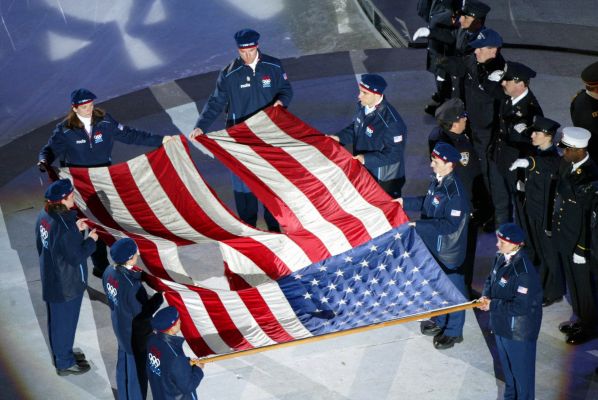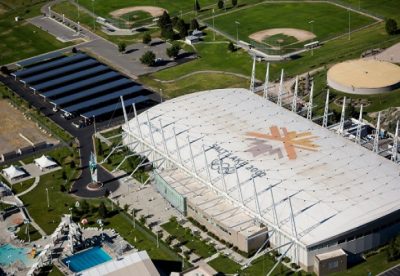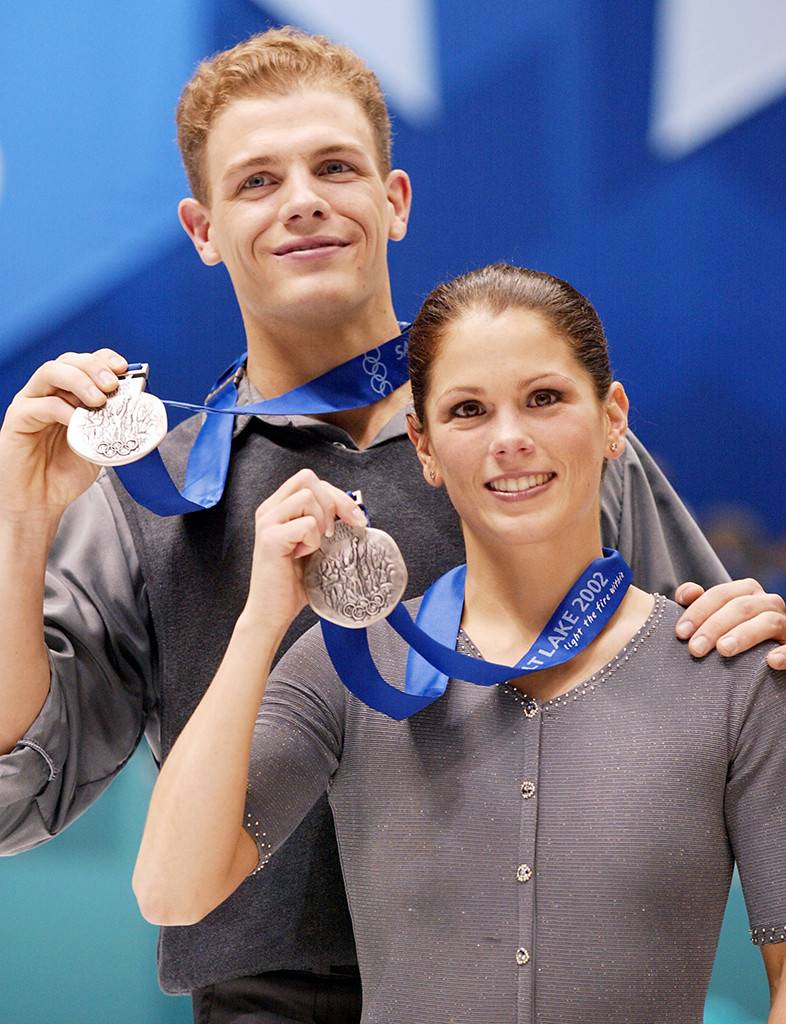On 8 February 2002, athletes and officials representing 77 National Olympic Committees – including for the first time athletes from Cameroon, Hong Kong, Nepal, Tajikistan, and Thailand – entered Rice-Eccles Stadium on the campus of the University of Utah for the Opening Ceremony of the Games of the XIX Winter Olympiad. It should be easy to understand that every moment in this Opening Ceremony had special resonance for most Americans. For some, it may have begun as the athletes marched into the stadium. Others might have reached the height of their emotion when George W Bush, standing in the midst of Team USA became the first American President to declare open a Winter Olympic Games. Still others might have been moved when Mike Eruzione and other members of the 1980 gold medal winning “Miracle on Ice” U S hockey team lit the cauldron with the Olympic Torch. For most, though, it was probably the moment near the beginning of the ceremony when an honor guard of Port Authority, NYPD, and NYFD personnel who were in New York on 11 September 2001 carried into the stadium this flag that had flown at the World Trade Center on that day less than five months earlier.
[Photo of World Trade Center flag from cdenewsday.com].
Increased security.
Coming in such proximity to the events of 11 September and with some vague echoes of the bombing in Centennial Park in Atlanta in 1996, the presence of an expanded state security apparatus was inevitable. A New York Times article published a month before the games detailed some of these new measures.
Secret Service agents will be used to secure all areas used for Olympic events. In the past, their role was confined to protecting the president and other dignitaries. The expanded presence represents the federal government’s largest security investment, $27.2 million, according to the government report.
For the first time in an Olympics in the United States — this is the eighth since 1904 — all law agencies, as well as military commanders, will operate as part of a unified Utah Olympic Public Safety Command.
Airspace over northern Utah will be heavily guarded, with AWACs surveillance planes on routine missions, F-16’s from nearby Hill Air Force Base on alert and added radar operating at Salt Lake City International Airport, where plans call for commercial traffic to be stopped at various times, including the opening and closing ceremonies.
In another new effort, the State Department and the Immigration and Naturalization Service are pooling resources to create an instant check on foreign visitors through a database that will let Customs officers determine immediately whether an Olympic athlete or official is on a United States watch list.
In addition, military forces will be stationed in and around the city. Mr. Romney said the commitment could reach up to 10,000 troops, including more than 2,000 from the Utah National Guard, the largest call-up ever in the state.
A torch-erous road.
I haven’t looked at an Olympic Torch Relay for awhile so I thought I’d revisit one. After the torch lighting in Greece, the flame was transported to Atlanta – the last U S city to host any Games – where it began a circuitous 13,500 mile (21,700 km) journey through 46 states (missing only Hawaii, Minnesota, North Dakota, and South Dakota) and the District of Columbia.
[Map from Wikipedia By UserMangoman88 CC BY-SA 3.0].
It was carried by 12,012 torchbearers including in the stadium such American Winter Olympic notables as Peggy Fleming and Scott Hamilton who passed the torch to Phil Mahre and Bill Johnson who passed it to Bonnie Blair and Dan Jansen who passed it to Jim and Jimmy Shea (honoring Jack Shea as the first three generation Olympians). They passed it on to Picabo Street and Cammi Granado who climbed the stadium stairs and handed it finally to Eruzione who was joined by his teammates in lighting the cauldron.
Is Olympic green becoming as important as Olympic gold?
Whether you’re following my chronology or the Olympic chronology, you will have read about the environmental efforts in Lillehammer to minimize the impact of the Games on the local environment. SLC’s Games carried that tradition forward.
Of the 11 venues used in the Games, six were newly constructed and five predated the decision to award hosting duties to SLC. Among the new venues was the Utah Olympic Oval, which hosted the speed skating competition and, at an altitude of 4,675 feet (1,425 m) holds the distinction of being the highest covered oval in the world.
[Utah Olympic Oval photo from nowplayingutah.]
The builders used a unique roof design that reduced the overall volume of the building by more than 840,000 cubic feet (28,300 cubic meters) allowing a significant reduction in the energy needed for heating and cooling. All of the venues – new and old – are currently in use.
Using carbon offsets the SLOC and its partners permanently removed more than 240,000 tons (243,840 metric tons) of carbon pollution. According to Olympics.com, “85 per cent of Games-time waste was recycled or composted, and 100,000 trees were planted in the state of Utah. In addition, 18 million trees were planted around the world through the Global Tree Race program.”
(In an interesting aside, the Delta Center {now Vivint Arena} which hosted figure skating, and short track speed skating, was temporarily renamed the Salt Lake Ice Center because Delta Airlines wasn’t an official sponsor, er, Olympic Partner.)
What’s a Winter Games without a figure skating scandal?
This particular scandal didn’t involve doping or a pre competition assault. (These were the first Winter Games held after the formation of the World Anti-Doping Agency. Naturally, this led for the first time to athletes being disqualified for failing a drug test. Two Russian and one Spanish cross-country skiers were the athletes so charged.) In SLC, the allegation was of a judging fix in the pairs figure skating competition. Here’s what happened:
In the short program Elena Berezhnaya and Anton Sikharulidze of Russia placed ahead of Canada’s Jamie Salé and David Pelletier who had tripped and fallen on their closing pose. During the free skate, Sikharulidze stepped out of a double axel – an error that, though minor, was apparent to all. Meanwhile, Salé and Pelletier (shown here with their original silver medals)
[From Figure Skating Wikia.]
skated flawlessly. At the time, figure skating judging was even more arcane than it is at present. Salé and Pelletier needed a score of 5.9 in artistic presentation from five judges to win the gold. They received four and outrage ensued.
Suspicion quickly fell on Marie-Reine Le Gougne, a French judge. When confronted, she initially said she had been pressured by the head of the French federation to put the Russians first as part of a deal to get the French ice dance team a gold medal. She later made several contradictory statements retracting her original admission. In the end, the IOC and International Skating Union upgraded Salé and Pelletier’s medals to gold with no silver medal awarded.
Meanwhile…
Here are some of the notable athletic achievements of the Games:.
- The U S Team won 34 medals (10g/13s/11b) nearly triple its previous best of 13 at any Winter Games.
- In the debut of women’s bobsleigh, Jill Bakken and Vonetta Flowers won gold medals. Flowers was the first African-American woman to win a gold medal at the Winter Olympics.
- Samppa Lajunen of Finland became the first Nordic combined athlete to win three gold medals at one Games – in the 15km, team, and spring.
- German luger Georg Hackl won the silver medal in singles luge and became the first person in Olympic history to earn a medal in the same individual event in five consecutive Games.
- Biathlete Ole Einar Bjørndalen of Norway won gold in all four men’s events (10 km, 12.5 km, 20 km, 4 x 7.5 km relay).
- Simon Ammann of Switzerland captured double gold in ski jumping.
- Janica Kostelić won the first Winter Olympic medals ever for an athlete from Croatia taking gold in the combined, giant slalom, and slalom and silver in the Super G.
- Canadians swept the ice hockey gold medals with the men’s team defeating the U S 5-2 and the women’s team also defeating the Americans by a 3-2 score. (Afterward, Team Canada’s executive director Wayne Gretzky told the press that a Loonie -the Canadian $1 coin – had been secretly placed at center ice by one of the ice technicians making the “lucky Loonie” a symbol of Canada’s victories in the tournament.)
- For Australians, the phrase “doing a Bradbury” was born when Steven Bradbury surprised the world by winning the 1,000 meter short track speed skating gold becoming the first athlete from a country in the Southern Hemisphere, to win a gold medal at the Winter Olympics. The Australian National Dictionary added the idiom in 2016.



